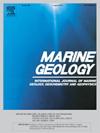Study on the morphodynamic response of reef flat with moveable bed to monochromatic waves
IF 2.6
3区 地球科学
Q2 GEOSCIENCES, MULTIDISCIPLINARY
引用次数: 0
Abstract
While carbonate sediment transport processes over coral reefs have been extensively investigated in the past decade,very few studies have focused on the morphodynamic response of sandy reef flats to wave action. In this study, a set of innovative wave-flume laboratory experiments was conducted for the first time to investigate the evolution of reef flat based on a barrier reef profile. Various monochromatic wave conditions (incident wave height, incident wave period and initial reef-flat water level) and sediment layer thicknesses were tested. A sand layer was paved on the reef flat to simulate a moveable bed and the reef surface roughness was replicated using an array of cylinders. Subsequently, a phase-resolving non-hydrostatic model (XBeach-NH) was adopted to simulate both the hydrodynamic and morphodynamic processes in the reef environment. A vegetation module was incorporated into Xbeach-NH to represent the rough reef surface. The adopted model was validated against the laboratory dataset for the first time as reported in this study. It was then used to examine the impacts of varying fore-reef slopes, sediment grain sizes and reef surface roughness on the morphodynamic response of sandy reef flats to monochromatic wave action. Model outputs suggested that projected sea-level rise, reduced reef surface roughness and increased storminess due to climate change have profound impacts on the morphodynamic processes on the reef flat thus may eventually contribute the geomorphological sustainability of reef islands.
可动床礁滩对单色波浪的形态动力学响应研究
虽然在过去十年中对珊瑚礁上的碳酸盐沉积物运输过程进行了广泛的研究,但很少有研究关注砂礁滩对波浪作用的形态动力学响应。在这项研究中,我们首次进行了一组创新的波浪水槽实验室实验,以研究基于堡礁剖面的礁滩演化。测试了各种单色波条件(入射波高、入射波周期和礁滩初始水位)和沉积层厚度。在礁面上铺设沙层以模拟可移动床,并使用一系列圆柱体复制礁表面粗糙度。随后,采用相位解析非流体静力模型(XBeach-NH)模拟了珊瑚礁环境中的水动力和形态动力过程。在Xbeach-NH中加入了一个植被模块来代表粗糙的珊瑚礁表面。本文首次采用实验室数据集对模型进行了验证。然后用它来研究不同的礁前斜坡、沉积物粒度和礁表面粗糙度对沙质礁滩对单色波浪作用的形态动力学响应的影响。模式结果表明,由于气候变化,预估的海平面上升、珊瑚礁表面粗糙度降低和风暴增加对礁滩的形态动力学过程产生了深远的影响,因此最终可能有助于礁岛地貌的可持续性。
本文章由计算机程序翻译,如有差异,请以英文原文为准。
求助全文
约1分钟内获得全文
求助全文
来源期刊

Marine Geology
地学-地球科学综合
CiteScore
6.10
自引率
6.90%
发文量
175
审稿时长
21.9 weeks
期刊介绍:
Marine Geology is the premier international journal on marine geological processes in the broadest sense. We seek papers that are comprehensive, interdisciplinary and synthetic that will be lasting contributions to the field. Although most papers are based on regional studies, they must demonstrate new findings of international significance. We accept papers on subjects as diverse as seafloor hydrothermal systems, beach dynamics, early diagenesis, microbiological studies in sediments, palaeoclimate studies and geophysical studies of the seabed. We encourage papers that address emerging new fields, for example the influence of anthropogenic processes on coastal/marine geology and coastal/marine geoarchaeology. We insist that the papers are concerned with the marine realm and that they deal with geology: with rocks, sediments, and physical and chemical processes affecting them. Papers should address scientific hypotheses: highly descriptive data compilations or papers that deal only with marine management and risk assessment should be submitted to other journals. Papers on laboratory or modelling studies must demonstrate direct relevance to marine processes or deposits. The primary criteria for acceptance of papers is that the science is of high quality, novel, significant, and of broad international interest.
 求助内容:
求助内容: 应助结果提醒方式:
应助结果提醒方式:


